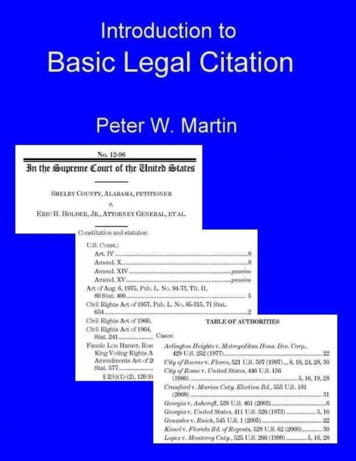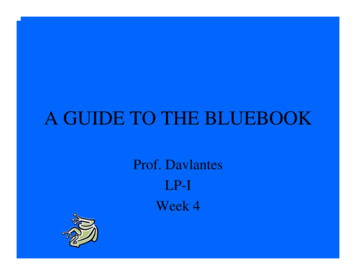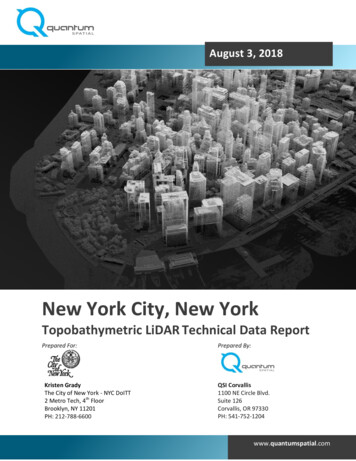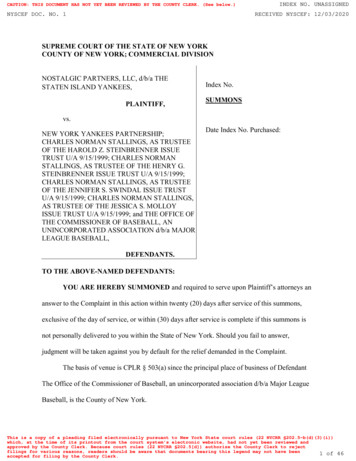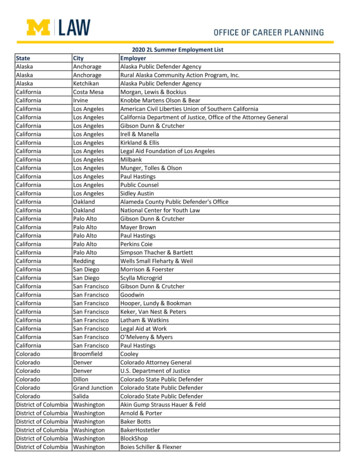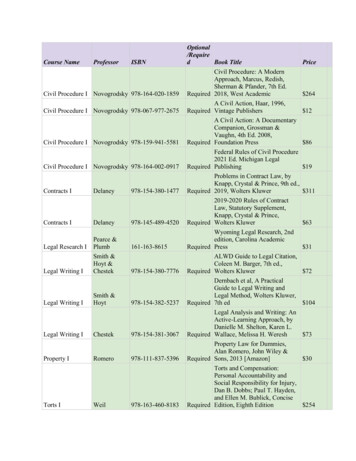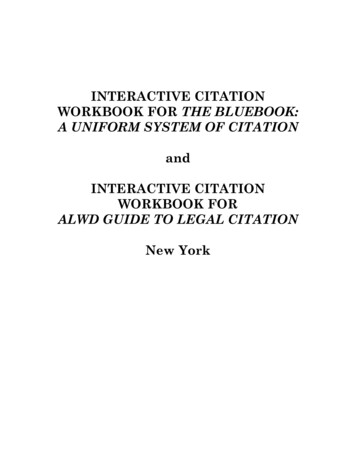
Transcription
INTERACTIVE CITATIONWORKBOOK FOR THE BLUEBOOK:A UNIFORM SYSTEM OF CITATIONandINTERACTIVE CITATIONWORKBOOK FORALWD GUIDE TO LEGAL CITATIONNew York
LexisNexis Law School PublishingAdvisory BoardPaul CaronProfessor of LawPepperdine University School of LawBridgette CarrClinical Professor of LawUniversity of Michigan Law SchoolSteven I. FriedlandProfessor of Law and Senior ScholarElon University School of LawCarole GoldbergJonathan D. Varat Distinguished Professor of LawUCLA School of LawOliver GoodenoughProfessor of LawVermont Law SchoolJohn SpranklingDistinguished Professor of LawMcGeorge School of Law
INTERACTIVE CITATIONWORKBOOK FOR THE BLUEBOOK:A UNIFORM SYSTEM OF CITATIONandINTERACTIVE CITATIONWORKBOOK FORALWD GUIDE TO LEGAL CITATIONNew YorkDebbie LaninLaw Clerk to the Honorable Arlene R. Lindsay, U.S. Magistrate JudgeFrank GulinoOf Counsel, Silver & Kelmachter, LLP
This publication is designed to provide accurate and authoritative information in regard to the subject mattercovered. It is sold with the understanding that the publisher is not engaged in rendering legal, accounting, orother professional services. If legal advice or other expert assistance is required, the services of a competentprofessional should be sought.LexisNexis, the knowledge burst logo, and Michie are trademarks of Reed Elsevier Properties Inc., used underlicense. Matthew Bender is a registered trademark of Matthew Bender Properties Inc.Copyright 2015 Matthew Bender & Company, Inc., a member of the LexisNexis Group. All Rights Reserved.No copyright is claimed in the text of statutes, regulations, and excerpts from court opinions quoted within thiswork. Permission to copy material exceeding fair use, 17 U.S.C. § 107, may be licensed for a fee of 25 per pageper copy from the Copyright Clearance Center, 222 Rosewood Drive, Danvers, Mass. 01923, telephone (978) 7508400.NOTE TO USERSTo ensure that you are using the latest materials available in this area, please be sure to periodicallycheck the LexisNexis Law School web site for downloadable updates and supplements atwww.lexisnexis.com/lawschool.Editorial Offices630 Central Ave., New Providence, NJ 07974201 Mission St., San Francisco, CA 94105-1831 (415) 908-3200www.lexisnexis.com(Pubs. 3125 & 3146)
NEW YORK CITATIONSA.INTRODUCTIONThere is no one prevailing source for citation of legal authorities in documents filed in New Yorkcourts. Rule 10.3.1 of The Bluebook: A Uniform System of Citation and Rule 12.4(b)(1)(a) of the ALWDCitation Manual: A Professional System of Citation provide that case citations in documents submitted tostate courts must conform with the local rules of that state. The local rules of New York, however, do notoffer much guidance.Rule 5529(e) of New York’s Civil Practice Law and Rules (CPLR), the state’s cognate of the FederalRules of Civil Procedure, requires that “New York decisions shall be cited from the official reports, if any.”Similarly, the rules of practice of several New York appellate courts, including the New York Court ofAppeals (the state’s highest court), also require the citation of New York decisions from the official reports, ifavailable. See N.Y. Ct. App. R. 500.1(g); N.Y. Sup. Ct. App. Div. 1st Dep’t R. 600.10(a)(11); N.Y. Sup. Ct.App. Div. 4th Dep’t R. 1000.4(f)(7). These rules deviate from general Bluebook and ALWD convention forcitation of state court decisions to the relevant unofficial West regional reporter. See Bluebook B4.1.3 (iv)(v); ALWD Rule 12.4(b)(1)(a).Beyond this one distinction, can the New York practitioner otherwise follow The Bluebook or theALWD Manual? The answer is not always.Citation conventions in New York are the result of longstanding tradition in practice, which oftenconflict with both The Bluebook and the ALWD Manual. For example, in order to determine the hierarchy ofcited authorities, New York practitioners specify the court and jurisdiction of the court being cited. Thus,where Rule 10.4(b) of The Bluebook instructs that writers omit the department or district of a state court inciting decisions of lower state courts “unless that information is of particular relevance,” a New Yorkpractitioner will always note the department of the Appellate Division, New York’s intermediate appellatecourt, from which a cited decision comes. E.g., Matter of Schulz, 1 A.D.3d 1 (1st Dep’t 2003). Similarly, aNew York practitioner will always note the county of the trial-level court from which a cited case comes,including the New York Supreme Court, the state’s trial court of general jurisdiction. E.g., Gallegos v. EliteModel Mgmt. Corp., 1 Misc. 3d 200 (Sup. Ct. N.Y. Cnty. 2003).This tradition is, in part, reflected in the New York Law Reports Style Manual, prepared by The LawReporting Bureau of the State of New York and published annually by Thomson West. The Style Manual,binding upon the courts of New York in the preparation of their opinions, is not binding upon legalpractitioners. Preface to the 2012 Edition. Traditional citation conventions are also reflected in New YorkRules of Citation, published by St. John’s Law Review of St John’s University School of Law. Both the StyleManual and New York Rules cite The Bluebook as a source of general rules on citation; however, unlike TheBluebook, the emphasis of both New York publications is the compilation of rules for the citation of NewYork legal authorities.In crafting this chapter, we consulted all of these sources as well as experts in New York citation.The resulting rules are an amalgam of the sources noted and reflect the citation rules used in practice.When Bluebook or ALWD rules are incorporated, the relevant rules will be identified.Finally, while CPLR 5529(e) does not preclude the citation of parallel sources for a decision, giventhe requirement of citation to official reports, many practitioners limit their citation to official reports whenthey are available. Thus, our rules are limited to the official reports. Of course, when a decision has notbeen published in the official reports, Rule 5529(e) permits citation of other, available sources.B.THE NEW YORK COURT SYSTEM AND THE OFFICIAL REPORTSTo understand the citation conventions in New York practice, it is important to understand theunique court system in the state.
1.Court of AppealsNew York’s highest court is the Court of Appeals. The seven-member court sits in Albany, the state’scapital. Decisions of the New York Court of Appeals are published officially in the New York Reports (N.Y.,N.Y.2d, N.Y.3d). With the exception of citing to the official reporter, New York practitioners otherwisefollow The Bluebook. As when citing decisions of other high courts, omit the name of the court in theparenthetical. Bluebook Rule 10.4(b).In addition, the initials of the state in the name of the official New York Reports obviate the need fora New York attorney to identify New York as the jurisdiction. Bluebook Rule 10.4(b); ALWD Rule12.4(d)(3)(g). Thus, only the year of decision is required.Kassis v. Teacher’s Ins. & Annuity Ass’n, 93 N.Y.2d 611 (1999).2.Intermediate Appellate CourtsNew York has three types of intermediate appellate courts:i.Appellate Division of the Supreme CourtThe statewide intermediate appellate court of New York is the Appellate Division of the state’sSupreme Court. The Appellate Division hears civil and criminal appeals from the trial courts as well as civilappeals from the Appellate Terms and County Courts, discussed below. Appeals from the Appellate Divisionare taken to the Court of Appeals. Much as the U.S. Court of Appeals, the intermediate appellate court inthe federal system, sits in various circuits throughout the country, the Appellate Division sits in fourdifferent Judicial Departments (First through Fourth) throughout the State of New York. And, much asthere can develop “circuit splits” in the federal court system until an issue is resolved by the U.S. SupremeCourt, in New York there can develop splits between and among the departments of the Appellate Divisionuntil the state’s highest court, the New York Court of Appeals, resolves the issue.Decisions of the Appellate Division are published officially in the Appellate Division Reports (A.D.,A.D.2d, A.D.3d). Because a trial court will be bound by a decision of the Appellate Division within theJudicial Department where the court sits (but not bound by a contrary decision in another Department),New York practitioners provide more detail than Table 1.3 of The Bluebook requires and include theDepartment of the court that decided the case in the court and date parenthetical. This is consistent withALWD Rule 12.6(b)(2) and Appendices 1 and 4. However, contrary to both The Bluebook and the ALWDManual, New York practitioners do not use the abbreviation “N.Y. App. Div.” Instead, they merely indicatethe Department using the following abbreviations: “1st Dep’t”; “2d Dep’t”; “3d Dep’t”; and “4th Dep’t.”Milea v. Ames Dep’t Store, Inc., 219 A.D.2d 798 (4th Dep’t 1995).ii.Supreme Court, Appellate TermThe Supreme Court, Appellate Term is an inferior appellate court which sits only in the First andSecond Judicial Departments. In the First Department, there is one Appellate Term. In the SecondDepartment, while there is one Appellate Term Clerk’s Office, there are two Appellate Terms, each with aPresiding Justice: One Appellate Term hears appeals from lower courts in the 2d, 11th, and 13th JudicialDistricts; the other hears appeals from lower courts in the 9th and 10th Judicial Districts.The Appellate Term hears matters from trial-level courts of limited jurisdiction within the countiesit serves, including appeals from civil and criminal cases originating in the Civil and Criminal Courts of theCity of New York. In the Second Department, the Appellate Terms also have jurisdiction over appeals fromcivil and criminal cases originating in District, City, Town and Village Courts, as well as non-felony appealsfrom the County Court.2
Decisions of the Appellate Term are published officially in the Miscellaneous Reports. When citingan Appellate Term decision, New York practitioners omit “N.Y.” from the court and date parenthetical andabbreviate Appellate Term as “App. T.” or “App. Term.” This is contrary to both Table 1.3 of The Bluebookand Appendix 1 of the ALWD Manual. In addition, New York practitioners identify the specific Departmentin which the court sits. This is contrary to Table 1.3 of The Bluebook but consistent with ALWD Rule12.6(b)(2) and Appendices 1 and 4.Hotel Martha Washington Mgmt. Co., 66 Misc. 2d 833 (App. T. 1st Dep’t 1971).When the Appellate Term decision being cited is from the Second Department, it is important also toinclude which Appellate Term decided the case by indicating the Judicial Districts covered by that particularAppellate Term. This is contrary to The Bluebook but consistent with ALWD Rule 12.6(b)(2).40-50 Brighton First Rd. Apts. Corp. v. Kosolapov, 39 Misc. 3d 27 (App. Term 2d Dep’t2d, 11th & 13th Dists. 2013).iii.County CourtsThe County Courts sit in every county of the State of New York outside of the five counties thatcomprise New York City. County Courts are primarily trial courts, but in the Third and FourthDepartments they do hear appeals of decisions in cases starting in the City Courts and Town and VillageCourts. Decisions of County Courts are published officially in the Miscellaneous Reports. Neither TheBluebook nor the ALWD Manual specifically addresses the County Courts. In citing to a decision of thiscourt, New York practitioners identify the particular county in which the court sits to indicate the weight ofauthority of the cited court. This is consistent with ALWD Rule 12.6(b)(2). Bluebook users abbreviate“County” as “Cnty.” T7. ALWD users abbreviate “County” as “Co.” 12.4(b) Examples & Appendix 1B NewYork.Clark v. Garth, 67 Misc. 2d 473 (Monroe Cnty. Ct. 1972).Clark v. Garth, 67 Misc. 2d 473 (Monroe Co. Ct. 1972).3.Supreme Court of the State of New YorkUnlike the Supreme Court of the United States or of nearly every other state, the Supreme Court ofthe State of New York is not the highest court in the state. Rather, it is the trial-level court of generaljurisdiction and sits in each of the 62 counties of the state. Decisions of the Supreme Court are publishedofficially in the Miscellaneous Reports. As the Supreme Court in each county is a court of coordinatejurisdiction with the court in every other county, it is important in citing a decision by a Supreme Court toinclude the county in which the cited court sits. This is more detail than is required by Table 1.3 of TheBluebook yet consistent with ALWD Rule 12.6(b)(2) and Appendix 1B New York. However, contrary to bothThe Bluebook and the ALWD Manual, New York practitioners do not include “N.Y.” in the court and dateparenthetical.Green v. DeMarco, 11 Misc. 3d 451 (Sup. Ct. Monroe Cnty. 2005).Green v. DeMarco, 11 Misc. 3d 451 (Sup. Ct. Monroe Co. 2005).4.Miscellaneous Trial CourtsThere are numerous trial-level courts in the State of New York in addition to the Supreme Court, thecourt of general jurisdiction. Other statewide trial courts include the Court of Claims (which adjudicatesclaims against the State), the Family Court (which hears matters involving children and families, includingadoption and custody cases), and the Surrogate’s Court (which hears estate and probate matters). Inaddition, there are trial courts of limited jurisdiction, including but not limited to County Courts (in countiesoutside the City of New York); the Civil Court of the City of New York; the Criminal Court of the City of New3
York; and City, Town, and Village Courts. The decisions of these and other trial-level courts are allpublished officially in the Miscellaneous Reports. Consistent with the above, when citing to these courts,New York practitioners always indicate the court and, where appropriate, the county in which the court sitsto indicate the weight of authority of the cited court.Lewis v. State, 69 Misc. 2d 1031 (Ct. Cl. 1972).Zeek v. Zeek, 74 Misc. 2d 758 (Fam. Ct. Queens Cnty. 1973).Zeek v. Zeek, 74 Misc. 2d 758 (Fam. Ct. Queens Co. 1973).Gramford Realty Corp. v. Valentin, 71 Misc. 2d 784 (Civ. Ct. N.Y. Cnty. 1972).Gramford Realty Corp. v. Valentin, 71 Misc. 2d 784 (Civ. Ct. N.Y. Co. 1972).C.DECISIONS NOT REPORTED IN THE OFFICIAL REPORTSWhere a decision is unavailable in the official reports, citation of the decision should be to the mostavailable unofficial source. That source may be, and often is, the New York Supplement (N.Y.S., N.Y.S.2d),the unofficial West reporter for New York decisions.Matter of Baron, 6 N.Y.S.2d 631 (Sup. Ct. Livingston Cnty. 1938).Matter of Baron, 6 N.Y.S.2d 631 (Sup. Ct. Livingston Co. 1938).Unpublished decisions may also be found online on LEXIS or Westlaw. Contrary to Rules B4.1.4 and18.3.1 of The Bluebook, when citing to widely-used electronic databases such as LEXIS or Westlaw,practitioners do not include the docket number after the case name. This rule is more consistent with Rule12.12(d) of the ALWD Manual which makes citation of the docket number optional.Conaway v. 200 W. 54th St. Corp., 1995 N.Y. App. Div. LEXIS 11508 (1st Dep’t Oct. 24,1995).Fourtounis v. N.Y.C. Hous. Auth., 2002 WL 31956105 (App. T. 2d Dep’t 2d & 11thDists. Sept. 25, 2002).Unpublished decisions may also be published in the New York Law Journal, a daily legal newspaperthat is often the only source of decisions, including Appellate Division decisions on motion practice. Whenciting to the New York Law Journal, practitioners include: (i) the case name; (ii) the abbreviation “N.Y.L.J.”;(iii) the date of the Journal; (iv) the first page in which the case appears preceded by “at”; (v) the columnnumber; and (vi) court and date parenthetical, including the date of the decision. This is contrary to generalcitation convention for periodicals in both The Bluebook and the ALWD Manual.Dinino v. D.A.T. Constr. Corp., N.Y.L.J., July 6, 1999, at 28, col. 3 (1st Dep’t July 1,1999).D.PROCEDURAL PHRASES IN CASE NAMESContrary to both Rule 10.2.1 (b) of The Bluebook and Rule 12.2(p) of the ALWD Manual,practitioners do not abbreviate expressions such as “in the matter of,” “petition of,” and “application of,” to“In re.” Instead, practitioners reduce case names that include such procedural phrases to “Matter of” and thename of the party. This elimination of procedural phrases and descriptive terms is consistent with BluebookRule 10.2.1(b) and (e) and ALWD Rule 12.2(p).Matter of Bridget Y., 93 A.D.3d 77 (4th Dep’t 2011).4
E.STATUTORY CITATIONSJust as with case citation, statutory citation conventions in New York are the result of longstandingtradition in practice, which often conflict with both The Bluebook and the ALWD Manual. For the New Yorkpractitioner, there are four primary differences.First, contrary to Bluebook Rule 12.3.1(d) and Table 1.3, and Appendix 1 of the ALWD Manual, NewYork practitioners usually cite New York statutes without specifying the publication in which they found thestatute. Note that New York does not have an official code. Instead, there are three unofficial codes:McKinney’s Consolidated Laws of New York, published by West; the New York Consolidated Laws Service,published by LexisNexis, and New York Consolidated Laws Unannotated, published by LexisNexis. Theunofficial code need not be identified in the date parenthetical.Energy Law § 3-101 (2012).Not: Energy Law § 3-101 (McKinney 2012).Second, contrary to Bluebook Table 1.3 and Appendix 1 of the ALWD Manual, New Yorkpractitioners omit reference to “N.Y.” when citing a New York statute in a document to be filed in a NewYork court.Aband. Prop. Law § 300 (2012).Not: N.Y. Aband. Prop. Law § 300 (2012).Third, because many New York statutes are codified by subject, The Bluebook and the ALWDManual dictate that the subject be identified in the citation and each provides a list of abbreviations persubject, to be followed by the word “Law.” Bluebook Table 1.3 & ALWD Appendix 2. For the New Yorkpractitioner, however, certain titles of law are regularly reduced to standard initials in citation which differfrom those provided in The Bluebook or the ALWD Manual and are not followed by the word “Law.” Forexample, the Estates, Powers and Trusts Law is regularly cited as “EPTL” and not “Est. Powers & TrustsLaw.” The Business Corporation Law is regularly cited as “BCL” and not “Bus. Corp. Law.” For those titlesof law so reduced to familiar initials, the section symbol (“§”) is omitted in citation of a particular provisionwithin those titles: UCC 2-201. The titles of law regularly reduced to initials in citation include: BusinessCorporation Law (BCL), Civil Practice Law and Rules (CPLR), Criminal Procedure Law (CPL), EminentDomain Procedure Law (EDPL), Environmental Conservation Law (ECL), Estates, Powers and Trusts Law(EPTL), General Obligations Law (GOL), Real Property Actions and Proceedings Law (RPAPL), Surrogate’sProcedure Act (SCPA), the Uniform Commercial Code (UCC), and the Vehicle and Traffic Law (VTL).GOL 5-1401.Not: GOL § 5-1401.The CPLR bears special mention in this connection, since its provisions include both “sections” and“rules.” Rather than requiring inclusion of a section symbol to cite “sections” and a redundant “R.” to cite“rules,” the CPLR itself advises the bench and bar that “[r]eference to a provision in the [CPLR] may, exceptwhen such provision is being enacted or amended, be made without indicating whether it is a rule orsection.” CPLR 101. The state courts and a vast majority of practitioners in New York follow the practice ofomitting any reference to whether a cited CPLR provision is a rule or section.CPLR 2212.Not: CPLR § 2212.5
CPLR 3212.Not: CPLR R. 3212.Conversely, some titles of law are spelled out and the abbreviations in The Bluebook and the ALWDManual are not used. For example, the Labor Law is regularly cited as “Labor Law” and not “Lab. Law” andthe Judiciary Law is regularly cited as “Judiciary Law” and not “Jud. Law.”Lastly, if relying on a print source, New York practitioners omit the year of the code. Similarly, ifrelying on an electronic database, they omit information regarding the currency of the database.F.ADMINISTRATIVE RULES AND REGULATIONSNew York administrative rules and regulations are published in the Official Compilation of Codes,Rules & Regulations of the State of New York. Contrary to Table 1.3 in The Bluebook and Appendix 1 in theALWD Manual, New York practitioners abbreviate this publication as “NYCRR.” The abbreviation ispreceded by the appropriate title number and followed by the appropriate section number. No sectionsymbol is used, and the date is omitted.12 NYCRR 23-1.7(b)(1).Not: N.Y. Comp. Codes R. & Regs. tit.12, § 23.1-7(b).G.DRY RUNWhew! Got all that? It’s really less complicated than it might seem. Let’s try one. Say that youwant to cite Hernandez v. Robles. The opinion was issued by the Appellate Division of the Supreme Court ofthe State of New York, First Judicial Department, in 2005. The opinion is printed in volume 26 of AppellateDivision Reports, Third Series, page 98. On appeal, that opinion was reversed by the New York Court ofAppeals in an opinion issued in 2006. That opinion is printed in volume 7 of the New York Reports, ThirdSeries, at page 338. First, get down the information you already know from completing past ICW exercises:Hernandez v. Robles, 26 A.D.3d 98.Then, add a parenthetical indicating the year of the decision, remembering to indicate the weight ofthe authority by including the Department of the Appellate Division that issued the opinion.Hernandez v. Robles, 26 A.D.3d 98 (1st Dep’t 2005).Then add the subsequent history of the case, indicating the reversal by the Court of Appeals.Hernandez v. Robles, 26 A.D.3d 98 (1st Dep’t 2005), rev’d, 7 N.Y.3d 338.Finally, add the parenthetical including the year of the reversal only.Hernandez v. Robles, 26 A.D.3d 98 (1st Dep’t 2005), rev’d, 7 N.Y.3d 338 (2006).That wasn’t so bad (or so different from “normal” rules of citation you have encountered in TheBluebook or the ALWD Manual). Let’s try another. Now you want to cite an opinion in Carrano v. Castro.The 2006 opinion was issued in the Appellate Term of the Supreme Court, Second Judicial Department, forthe 2nd and 11th Judicial Districts. The opinion is printed in volume 12 of Miscellaneous Reports, ThirdSeries, at page 5. Start with the basics:Carrano v. Castro, 12 Misc. 3d 5.6
Then, add a parenthetical indicating the year of the decision. Remember to add reference to theAppellate Term in the parenthetical, since the Miscellaneous Reports publishes not only opinions of theAppellate Term, but of the many trial-level courts in the State of New York. Since there are AppellateTerms in both the First and Second Departments, don’t forget to include reference to the Second Departmentin the parenthetical.Carrano v. Castro, 12 Misc. 3d 5 (App. T. 2d Dep’t 2006).But you’re not done! Because there are two different Appellate Term benches within the SecondDepartment, remember to indicate the weight of the authority by including the Judicial Districts covered bythis specific Appellate Term court.Carrano v. Castro, 12 Misc. 3d 5 (App. T. 2d Dep’t 2d & 11th Dists. 2006).That’s it!How about one more (including a citation of a trial-level decision)? The case is Sharp v. Scandic WallLtd. P’ship. You want to cite an opinion deciding a pretrial motion, issued by the state Supreme Court, NewYork County, in 2002, and affirmed by the Appellate Division, First Department, in 2003. The SupremeCourt’s opinion is printed in volume 195 of Miscellaneous Reports, Second Series, at page 254. So, the basiccitation is:Sharp v. Scandic Wall Ltd. P’ship, 195 Misc. 254.We’ve already recognized that because the Miscellaneous Reports includes decisions from so manydifferent courts, citation to this reporter requires us to specify the court that decided the case in theparenthetical with the year of the decision. In addition, because there is a state Supreme Court in each ofthe 62 counties of the state, we must include the county as well as the name of the court in thatparenthetical.Sharp v. Scandic Wall Ltd. P’ship, 195 Misc. 2d 254 (Sup. Ct. N.Y. Cnty. 2002).Not so complicated. Now, you just have to add the subsequent affirmance by the Appellate Division.It is printed in volume 306 of the Appellate Division Reports, Second Series, at page 39. Don’t forget toinclude the Department of the Appellate Division that decided the case!Sharp v. Scandic Wall Ltd. P’ship, 195 Misc. 2d 254 (Sup. Ct. N.Y. Cnty. 2002), aff’d, 306A.D.2d 39 (1st Dep’t 2003).Great! You’re ready for some exercises now!7
Checklist for New York Citation Is your case cited in the official reports? If so, cite to the official reporter. Parallel citation is notrequired. If citing to a decision of the New York Court of Appeals, your parenthetical should include ONLY theyear the decision was published. If citing to a decision of the Appellate Division of the Supreme Court, did you identify theDepartment that decided the case in your court and date parenthetical? Did you properly abbreviatethe Departments as follows: 1st Dep’t; 2d Dep’t; 3d Dep’t; 4th Dep’t? If citing to the Appellate Term of the Supreme Court, did you identify the Department in which thecourt sits? If citing to an Appellate Term decision from the Second Department, did you includewhich Appellate Term decided the case by indicating the Judicial Districts covered by that particularAppellate Term? If citing to a trial level court, did you identify the court and, where appropriate, the county in whichthe court sits? If citing to a statutory provision: did you check to see if your cite is one which is regularly reduced to initials? If so, didyou omit the section symbol? did you omit reference to “N.Y.” before the statute name? did you omit reference to the publication and the date in your parenthetical?If citing to a regulation, did you properly abbreviate the NYCRR? Did you omit the section symboland title number? Did you omit the date?8
New York's highest court is the Court of Appeals. The seven-member court sits in Albany, the state's capital. Decisions of the New York Court of Appeals are published officially in the New York Reports (N.Y., N.Y.2d, N.Y.3d). With the exception of citing to the official reporter, New York practitioners otherwise follow The Bluebook. As when .
